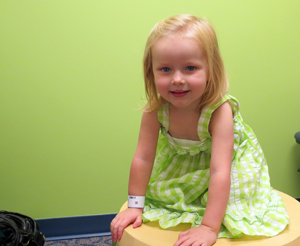
When you hear the term, “kidney stones,” you probably wouldn’t think a blue-eyed, blond-haired 2-year-old is someone who suffers from the painful condition. After all, kidney stones are most common in adults age 40 and older.
Yet over the past decade, prevalence of kidney stones in kids has increased, says Dr. Joel Hernandez, nephrologist at Seattle Children’s Hospital.
It’s this increase that prompted creation of a new clinic at Seattle Children’s – one that exists solely to diagnose and treat kids with kidney stones.
The multidisciplinary Kidney Stones Clinic is made up of physicians, nurses and medical assistants from the Nephrology and Urology clinics, as well as dietitians and family service coordinators. The clinical team members meet as a group with each patient and their family members to provide education and comprehensive care to help manage the patient’s stones.
The clinic is the only program of its type in Washington state and started seeing patients in March 2013.
That’s about the same time Nichole and Cody Zietz found themselves searching for answers to why their baby girl, Ada, wasn’t growing well.
Doctors in their hometown of Spokane, Wash., discovered that Ada had a urinary tract infection. An ultrasound confirmed that she also had too much calcium in her kidneys. At 10 months old, baby Ada passed her first kidney stone.
Ada was diagnosed with primary hyperoxaluria, a hereditary kidney disorder that leads to excessive oxalate in her body, which, when combined with calcium, forms kidney stones.
Soon, the Zietzes began making the nearly 300-mile drive to Seattle Children’s every three months for a Kidney Stones Clinic visit.
“It used to be that we would separately take care of patients,” says Hernandez. “Nephrology would see a patient with stones, and if there was a need for urological evaluation or surgery, they would be referred to Urology.” At the Kidney Stones Clinic, patients like Ada can be seen by her entire team of clinicians in the same room, at the same time.
Nichole says the clinic format – seeing four or more clinicians all at once – works for her family. “It makes sense especially for kidney stones to have everyone who deals with treatment in the room rather than have us try to relay information back and forth,” she says.
One condition, many causes
Kids can develop kidney stones for a number of reasons. For Ada, the root cause is a genetic disorder. For others, it may be due to diet, medications or other factors like immobilization (which causes bones to thin and release calcium).
Depending on a child’s circumstances, stones may occur just once; or they may have multiple stones in their lifetime.
The Kidney Stones Clinic team’s goal is to provide long-term management so kids will have fewer stones.
The team works together to create individual plans for each patient that may include diet changes, supplements and medication.
When kidney stones do manage to form despite medication and diet changes, patients may require surgery to remove or break up the stones. Surgery can be risky, though.
Depending on the type of surgery and the frequency, the procedures can damage the urinary tract and cause obstruction.
“We do as much as we can with the patient’s diet,” says Kirsten Thompson, dietitian in the clinic. Two of the most important changes a patient can make to reduce stones are to drink more water and eat less salt.
Diet changes are most effective in kids whose stones formation is due to poor diet. “I call it typical teen diet: low amounts of fruits, vegetables, dairy and water, and a lot of high-salt junk food and soda,” says Thompson.
Kirsten uses a Low-Sodium Eating handout to talk with families about low-salt diets on any budget. She knows it isn’t always realistic to expect a family to eat fresh, made-from-scratch meals, so she even has strategies to reduce salt in pre-packaged foods for families on a low income budget. For example, her tips for eating super-inexpensive ramen noodles: throw out the broth and use less of the seasoning packet.
Although Ada’s kidney stones aren’t caused by poor diet, her stone formation can be lessened with diet changes. “She’s on extremely high fluid intake,” says Cody. “She gets about a liter and a half of fluid every day, minimum.” Ada also takes vitamin B6 to help process her excess oxalate.
Ada is responding well to her treatment plan; she hasn’t had a major stone in a year. In fact, she’s doing so well, the Zeitzes have been able to reduce the frequency of their clinic visits to just one a year.
If you’d like a referral to Seattle Children’s Kidney Stone Clinic, talk with your child’s primary care provider. To schedule an appointment, please call 206-987-2524 option 2.

